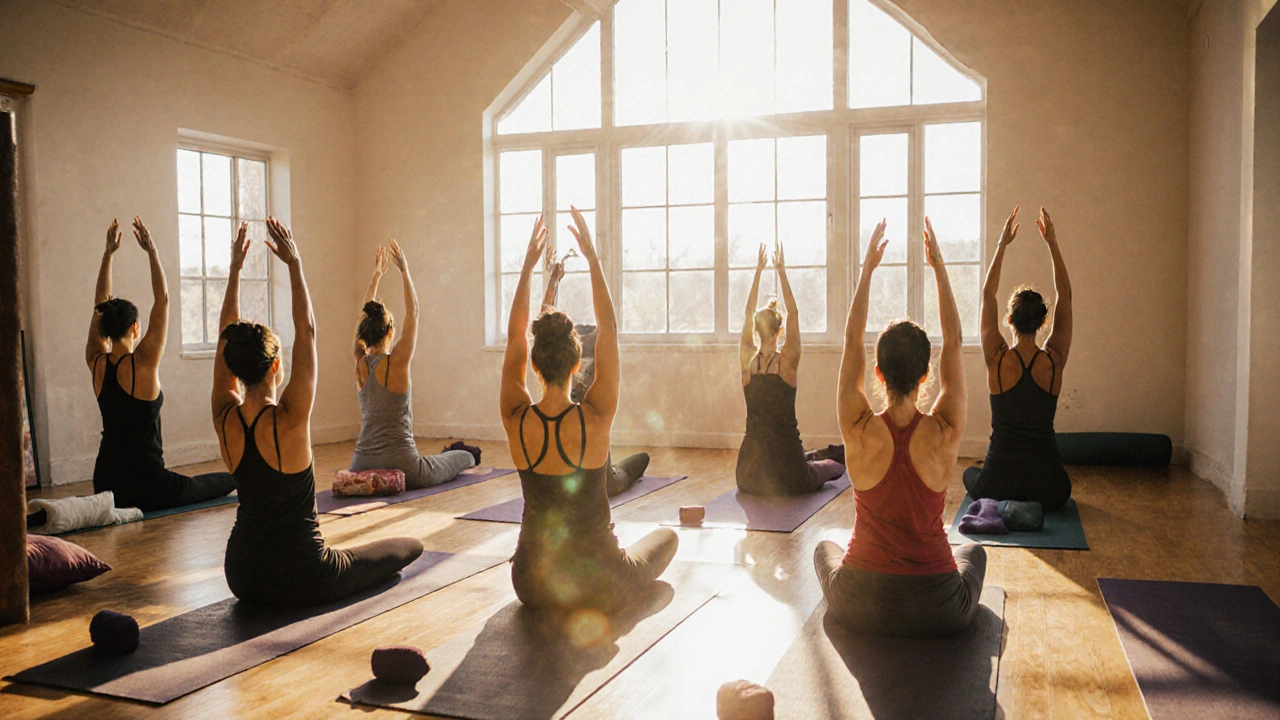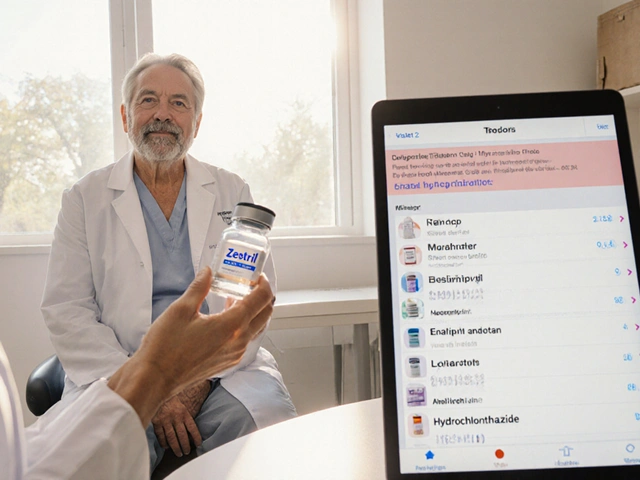Asthma Breathing Technique Timer
Select Your Technique
Box Breathing (4-4-4-4)
Inhale 4s, hold 4s, exhale 4s, hold 4s. Repeat for 5 cycles.
Alternate Nostril Breathing
Breathe in through right, exhale through left. Inhale left, exhale right.
Diaphragmatic Breathing
Breathe deeply through nose, feel belly expand. Exhale slowly.
Relaxation Sequence
3 minutes of guided relaxation with slow, deep breaths.
Breathing Timer
Recommended for: Diaphragmatic Breathing
Yoga for asthma can be a game‑changer for people who struggle with wheezing, coughing, and tight chests. Below are the key points you’ll walk away with:
- Yoga improves lung capacity and airway flexibility.
- Meditation lowers stress‑induced asthma attacks.
- Targeted breathing techniques can reduce rescue‑inhaler use.
- Regular practice supports long‑term asthma control alongside medication.
- Safe, low‑impact poses make it easy for beginners.
Why Yoga Helps Asthma
When it comes to breathing easier, Yoga is a mind‑body practice that blends postures, breath control, and meditation to improve lung capacity. The physical side-called Breathing Techniques-teaches diaphragmatic breathing, which recruits the lower lungs and reduces the work of the chest muscles. Over time, this strengthens the diaphragm and can increase Pulmonary Function metrics like forced vital capacity (FVC).
Yoga also encourages an upright spine and open chest, giving the lungs more room to expand. Poses such as the Camel (Ustrasana) and Bridge (SetuBandhasana) gently stretch the thoracic cavity, while twisting poses improve rib mobility. The result? Less airway resistance during an asthma flare‑up.
Meditation’s Role in Reducing Triggers
Meditation isn’t just about sitting quietly; it trains the Autonomic Nervous System to stay calm. When stress spikes, the body releases cortisol and histamine, both of which can tighten airway muscles. Regular mindfulness practice lowers these stress hormones, which translates to fewer spontaneous asthma attacks.
Studies from 2023 and 2024 show that participants who meditated for 10 minutes daily experienced a 15‑20% reduction in nighttime symptoms. The calming effect also improves sleep quality, an often‑overlooked factor in asthma control.

Specific Yoga Poses and Meditations for Asthma
Here’s a starter routine you can do at home. Aim for 15‑20 minutes, three times a week.
- Cat‑Cow Flow (Marjaryasana‑Bitilasana): Warm up the spine and sync breath with movement.
- Standing Forward Bend (Uttanasana): Lengthens the back, opens the rib cage, and encourages slow, deep inhales.
- Bridge Pose (SetuBandhasana): Strengthens the diaphragm and gently expands the chest.
- Camel Pose (Ustrasana): Deep chest opener-hold for 30 seconds, breathing evenly.
- Alternate Nostril Breathing (NadiShodhana): Balances the nervous system and improves oxygen intake.
- Box Breathing (4‑4‑4‑4): Inhale4, hold4, exhale4, hold4; repeat for 5 cycles.
- Finish with a 5‑minute guided mindfulness meditation focused on the sensation of the breath.
Adjust the depth of each pose based on comfort; the goal is to move without strain.
Integrating Yoga & Meditation with Conventional Treatment
Yoga and meditation act as adjuncts, not replacements, for prescribed Inhalers. Keep your rescue inhaler handy, especially during the first few weeks as you gauge how your symptoms respond. Many doctors recommend a “step‑down” approach: if your asthma control improves, you might discuss lowering the dose of controller medication with your pulmonologist.
Key integration tips:
- Log daily symptoms and practice time in a journal.
- Share your yoga routine with your healthcare provider during check‑ups.
- Never skip a prescribed dose because you felt better after a session.
When used together, the anti‑inflammatory effects of consistent breathing work can complement the bronchodilation from medication, leading to fewer emergency visits.

Safety Tips and Common Pitfalls
Even low‑impact activities can backfire if done incorrectly.
- Warm‑up first. Jumping straight into deep backbends can trigger a sudden airway constriction.
- Avoid over‑exertion. If you feel breathless, pause and practice gentle diaphragmatic breaths.
- Watch the environment. Cold, dry air can irritate airways; practice indoors on chilly days.
- Stay hydrated. Moisture keeps mucus thin, making it easier to clear.
- Consult a professional. A certified yoga therapist experienced with respiratory conditions can tailor poses.
Quick Comparison: Yoga vs Traditional Asthma Management
| Aspect | Yoga & Meditation | Standard Medication |
|---|---|---|
| Primary Action | Improves lung mechanics, reduces stress | Bronchodilation, anti‑inflammation |
| Onset of Relief | Minutes‑to‑hours (post‑session) | Seconds (quick‑relief inhaler) |
| Side Effects | Rare, usually mild soreness | Possible tremor, heart rate increase |
| Long‑Term Benefits | Enhanced airway flexibility, lower stress hormones | Controlled inflammation, reduced exacerbations |
| Cost (per month) | Low - yoga class or online video | Variable - inhalers, doctor visits |
Frequently Asked Questions
Can yoga replace my inhaler?
No. Yoga is an excellent complement, but it doesn’t act as a bronchodilator. Keep your rescue inhaler for sudden attacks.
How often should I practice to see results?
Most experts suggest 15‑20 minutes, three to five times a week. Noticeable improvements in symptom frequency often appear after 4‑6 weeks.
Are there specific poses to avoid?
Deep inversions (e.g., headstand) can raise intra‑abdominal pressure and should be avoided unless cleared by a medical professional.
Can children with asthma benefit from yoga?
Absolutely. Gentle, playful sequences keep kids engaged while teaching proper breathing. Always supervise and tailor intensity to the child’s age.
What’s the best time of day to practice?
Morning sessions prime the lungs for the day, but evening practice can calm nighttime triggers. Choose what fits your schedule.
Do I need special equipment?
A non‑slip yoga mat and a bolster or pillow for support are enough. Props help maintain proper alignment without strain.
How does meditation lower inflammation?
Mindfulness reduces cortisol and sympathetic nervous system activity, both of which are linked to airway inflammation. Consistent practice can lower baseline inflammatory markers.









October 13, 2025 AT 18:47
Annie Tian
What a wonderful synthesis of yoga breathing techniques for asthma management! The step‑by‑step layout is clear; the timer interface is intuitive; the descriptions are concise yet thorough; the inclusion of box breathing, alternate nostril, diaphragmatic, and relaxation sequences offers a comprehensive toolkit for patients.
October 19, 2025 AT 13:40
April Knof
From its origins in ancient Indian asana practice, yoga has always intertwined breath and movement; incorporating these time‑tested pranayama methods into modern asthma care honors that tradition while providing accessible, low‑cost relief for diverse communities.
October 25, 2025 AT 08:33
Tina Johnson
While the article presents useful tools, the omission of peer‑reviewed evidence and quantitative outcomes seriously undermines its scientific credibility; a rigorous citation of clinical studies would be essential to substantiate the claimed benefits.
October 31, 2025 AT 03:27
Sharon Cohen
Nevertheless, one must acknowledge that controlled breathing alone cannot replace pharmacological therapy; overreliance on such techniques may give patients a false sense of security, potentially delaying critical medical intervention.
November 5, 2025 AT 22:20
Rebecca Mikell
I appreciate the practical approach and would suggest adding a brief reminder to consult a healthcare professional before adopting new breathing routines, ensuring safety and personalized guidance.
November 11, 2025 AT 17:13
Ellie Hartman
Remember to start each session with gentle neck stretches and to focus on diaphragmatic expansion; consistency over weeks often yields the most noticeable improvement in airway stability.
November 17, 2025 AT 12:07
dany prayogo
Oh, brilliant, another web page promising that simply inhaling and exhaling will miraculously cure asthma-how original! The timer widget looks like something a kindergarten class might use, yet we are supposed to take it seriously? Perhaps the developers believe that by counting seconds we can somehow out‑wit a chronic inflammatory disease. Let’s not forget the magical box breathing method, a secret passed down by mystics who never needed inhalers. The alternate nostril technique is presented as a panacea for airway constriction. Diaphragmatic breathing is apparently the silver bullet, as if the diaphragm has a hidden switch for bronchial constriction. The relaxation sequence promises peace, yet it does not address the real triggers-pollution, allergens, and genetics. All of these “techniques” ignore the necessity of prescribed corticosteroids, which, surprise, actually work. The interface relies on bright colors and progress bars, which are obviously more motivating than proper education. Users are invited to “select a technique” as if health decisions are akin to choosing a coffee flavor. The article’s lack of citations reads like a personal blog rather than a medical guide. In short, if you have asthma, you might as well try this and hope for the best, because evidence‑based treatment is clearly overrated. Meanwhile, the timer’s reset button is an existential metaphor for the endless cycle of hope and disappointment. The code snippet buried in the page suggests that the developers are more comfortable with JavaScript than with clinical research. Ultimately, the only thing this page guarantees is that you will spend a few minutes breathing while wondering why your inhaler is still on the shelf.
November 23, 2025 AT 07:00
Wilda Prima Putri
Sure, because breathing is totally a hobby.
November 29, 2025 AT 01:53
Edd Dan
I definatly think it's great that people are exploring mindful breathing, and we should all support each other's efforts, even if the science isnt fully settled yet; lets reciev new ideas and keep the conversation open and respectful.
December 4, 2025 AT 20:47
Cierra Nakakura
Wow, this timer looks so fun to use! I can already feel the energy building up-let's do some box breathing together 😊
December 10, 2025 AT 15:40
Sharif Ahmed
One cannot simply gloss over the profound philosophical underpinnings of pranayama; the very act of conscious respiration is a sacred dialogue between the self and the cosmos, transcending mundane therapeutic conventions.